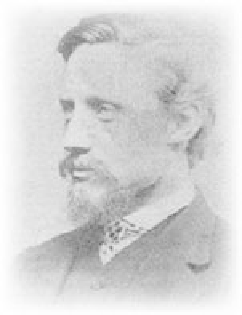Geoscience Reference
In-Depth Information
measured the pressure drop over a length of smooth pipe
through which water was passed at various speeds. As we
have seen in Sections 3.12 and 4.1, pressure drop is due
to energy losses to heat as fluid moves, accompanied by
conversion of potential to kinetic energy. Pressure loss per
unit pipe length increased with velocity in a straightfor-
ward linear fashion, but at a certain point the losses began
to increase more quickly, as the 1.8 power of the velocity
(Fig. 4.9). Measurements confirmed Reynolds' intuition
that this implied change in force balance was accompanied
by the previously observed change in flow pattern from
“direct” to “sinuous.”
4.2.4 More on scaling and the fundamental
character of the Reynolds number
The origin of the
Re
criterion as a fundamental indicator of
flow type must be sought ultimately in the equations of
motion (Sections 3.2 and 3.12) and in the interplay
between forces trying to destabilize laminar flow and those
trying to control the deformation (Fig. 4.10). Turbulent
acceleration is the advective kind in which a nonlinear form
of the velocity change is implied by terms like
u
(
u
/
x
)
and
y
), that is, the terms involve squares of the veloc-
ity that grow rapidly as velocity increases. Let us simplify
the approach by assuming that to first order the overall
term varies as
u
2
/
l
. The viscous friction force (Section 3.10)
is proportional to the rate of change of velocity gradient
that is, (
(
u
/
4.2.2 A general statement establishing universal
flow types
times the coefficient of kinematic vis-
cosity. To first order this can be written as
2
u
/
z
2
)
u
/
l
2
. The ratio
of the acceleration term to the viscous one gives an idea of
Reynolds repeated the pipe experiments with different pipe
diameters (the pipes always being smooth) and with the
water at different temperatures so that viscosity, the “physi-
cal constant” noted in the quote above, could be varied. He
showed that the critical velocity for the onset of turbulence
was not the same for each experiment and that the change
from laminar to turbulent flow occurred at a fixed value of a
quantity of variables that has become known as the
Reynolds
number
(
Re
) in honor of its discoverer. We may think of
Re
as a ratio of two forces acting in a fluid (Fig. 4.10). Viscous
forces resist deformation: the greater the molecular viscosity,
the greater the resistance. Inertial forces cause fluid acceler-
ation.
Re
may be derived from first principles in this way as
shown in Fig. 4.10. When viscous forces dominate, as say in
the flow of liquefied mud or lava, then
Re
is small and the
flow is laminar. When inertial forces dominate, as in atmos-
pheric flow and most water flows, then
Re
will be large and
the flow turbulent. For flows in pipes and channels, the crit-
ical value of
Re
for the laminar-turbulent transition usually
lies between 500 and 2,000, but this depends upon entrance
conditions and can be very much larger.
Shear
stress
Velocity gradient,
d
u
/d
y
, is order
u
/
l
,
t
u
advective acceleration
u
d
u
/d
l
, is of order
u
2
/
d
u
/d
y
l
l
Unit volume
of fluid
viscosity,
m
,
density,
u
= 0
-
τ
Viscous force = shear stress per area
=
2
=
2
=
2
/
t
l
m
d
u
/dy
l
m
u
l
l
=
m
u
l
Inertial force = mass x acceleration
=
3
u
2
/
2
u
2
r
l
l
=
r
l
Reynolds, number, Re = inertial force/viscous force
2
u
2
/
m
l
u
=
ru
l
/
m
=
l
u
/
n
=
r
l
4.2.3
Turbulence is a property of a flow, not a fluid
We should be careful in any identification of laminar flow
with high viscosity liquids alone. As Reynolds himself
took great pains to emphasize, a flow state is dependent
upon four parameters of flow, not just one. Thus a very
low density or very low velocity of flow has the same
reducing effect on
Re
as a very high viscosity. As Shapiro,
the author of a classic introductory text in fluid mechanics,
states “it is more meaningful to speak of a very viscous
situation than a very viscous fluid.”
The birth of eddies
depends on some
definite
value of
lu
/
n
Reynolds
Fig. 4.10
Simple derivation of Reynolds number.


















Search WWH ::

Custom Search